A Comparison of Scientific Management and Human Relations Theories
VerifiedAdded on 2022/11/14
|8
|2028
|274
Essay
AI Summary
This essay provides a comprehensive comparison and contrast of two pivotal management theories: scientific management, championed by Frederick Taylor, and the human relations movement, spearheaded by Elton Mayo and his colleagues. The introduction sets the stage by defining the core principles of each theory and their aims to enhance workplace efficiency. Scientific management, rooted in the industrial era, emphasizes the optimization of work processes through systematic analysis and control, treating employees as components in a machine-like system. Conversely, the human relations approach, born from the Hawthorne studies, highlights the significance of social and psychological factors in the workplace, recognizing the importance of employee relationships, motivation, and overall well-being. The essay delves into the key figures, principles, and related theories associated with each approach, including the contributions of Adam Smith, Mary Parker Follett, and Chester Barnard. The analysis examines the strengths and weaknesses of each perspective, particularly in the context of modern business environments. The conclusion argues that while scientific management laid the groundwork for efficiency, the human relations approach offers a more nuanced and effective framework for managing individuals and fostering organizational success in the contemporary era. The essay concludes that the human relations approach represents a significant improvement over the scientific management approach.
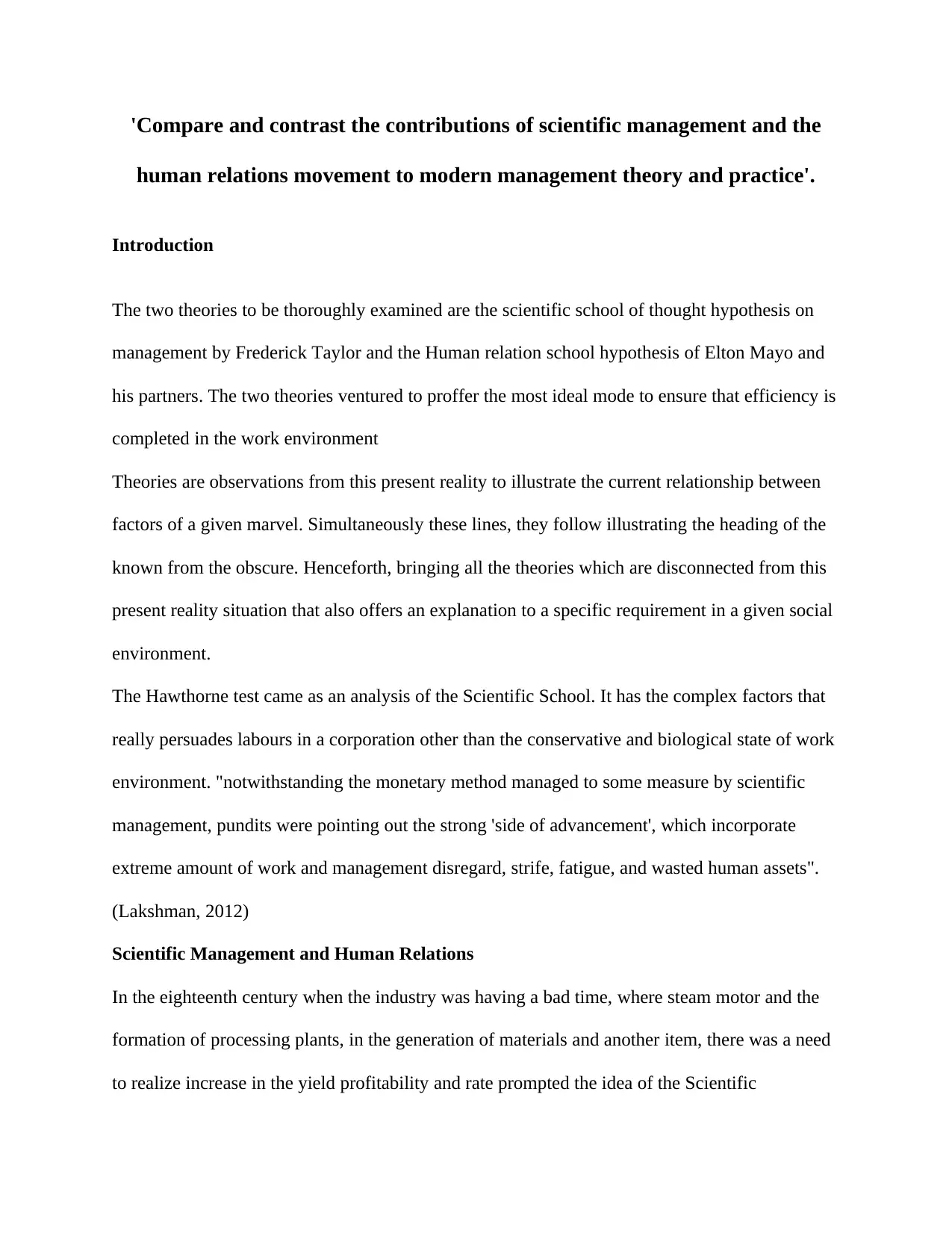
'Compare and contrast the contributions of scientific management and the
human relations movement to modern management theory and practice'.
Introduction
The two theories to be thoroughly examined are the scientific school of thought hypothesis on
management by Frederick Taylor and the Human relation school hypothesis of Elton Mayo and
his partners. The two theories ventured to proffer the most ideal mode to ensure that efficiency is
completed in the work environment
Theories are observations from this present reality to illustrate the current relationship between
factors of a given marvel. Simultaneously these lines, they follow illustrating the heading of the
known from the obscure. Henceforth, bringing all the theories which are disconnected from this
present reality situation that also offers an explanation to a specific requirement in a given social
environment.
The Hawthorne test came as an analysis of the Scientific School. It has the complex factors that
really persuades labours in a corporation other than the conservative and biological state of work
environment. "notwithstanding the monetary method managed to some measure by scientific
management, pundits were pointing out the strong 'side of advancement', which incorporate
extreme amount of work and management disregard, strife, fatigue, and wasted human assets".
(Lakshman, 2012)
Scientific Management and Human Relations
In the eighteenth century when the industry was having a bad time, where steam motor and the
formation of processing plants, in the generation of materials and another item, there was a need
to realize increase in the yield profitability and rate prompted the idea of the Scientific
human relations movement to modern management theory and practice'.
Introduction
The two theories to be thoroughly examined are the scientific school of thought hypothesis on
management by Frederick Taylor and the Human relation school hypothesis of Elton Mayo and
his partners. The two theories ventured to proffer the most ideal mode to ensure that efficiency is
completed in the work environment
Theories are observations from this present reality to illustrate the current relationship between
factors of a given marvel. Simultaneously these lines, they follow illustrating the heading of the
known from the obscure. Henceforth, bringing all the theories which are disconnected from this
present reality situation that also offers an explanation to a specific requirement in a given social
environment.
The Hawthorne test came as an analysis of the Scientific School. It has the complex factors that
really persuades labours in a corporation other than the conservative and biological state of work
environment. "notwithstanding the monetary method managed to some measure by scientific
management, pundits were pointing out the strong 'side of advancement', which incorporate
extreme amount of work and management disregard, strife, fatigue, and wasted human assets".
(Lakshman, 2012)
Scientific Management and Human Relations
In the eighteenth century when the industry was having a bad time, where steam motor and the
formation of processing plants, in the generation of materials and another item, there was a need
to realize increase in the yield profitability and rate prompted the idea of the Scientific
Paraphrase This Document
Need a fresh take? Get an instant paraphrase of this document with our AI Paraphraser
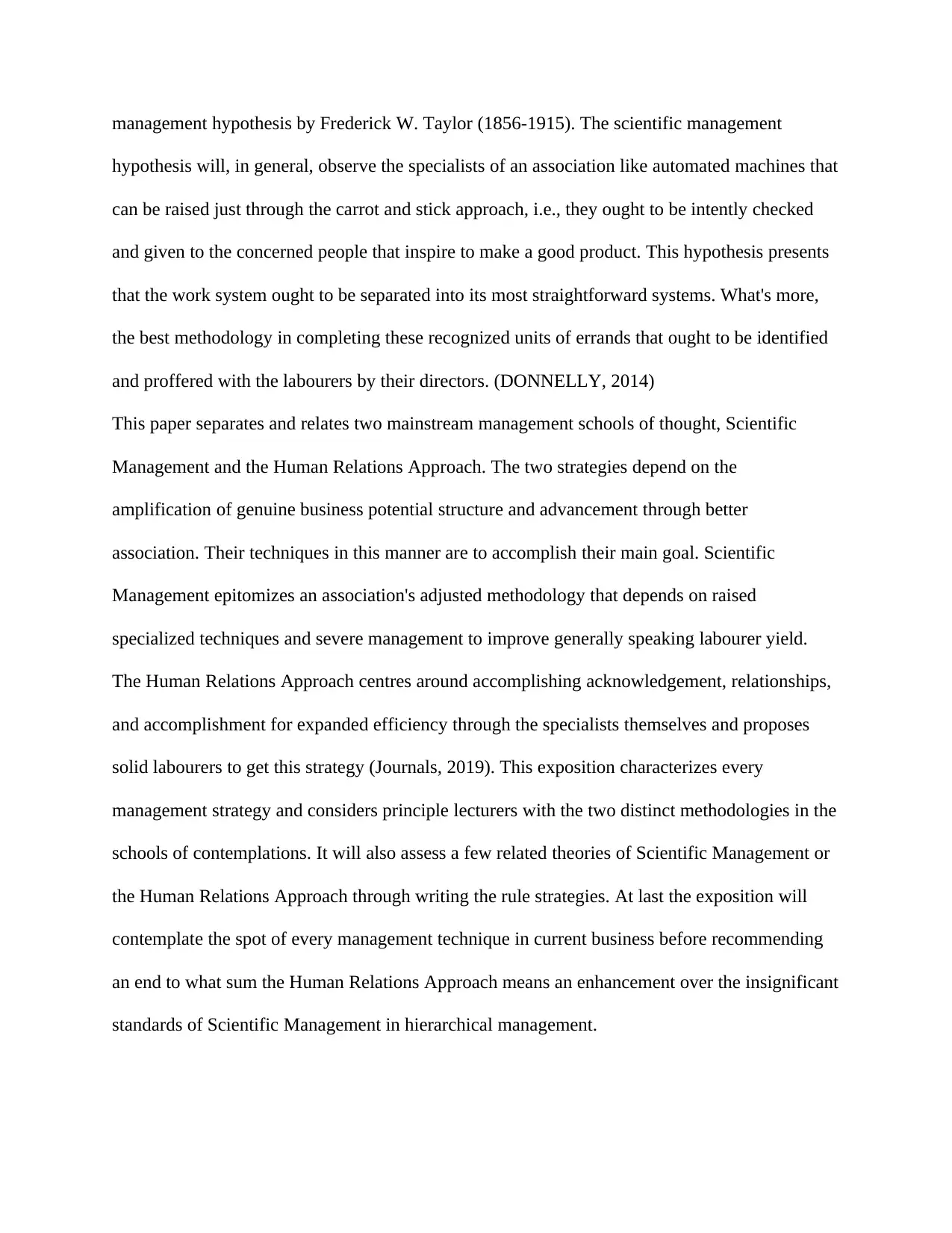
management hypothesis by Frederick W. Taylor (1856-1915). The scientific management
hypothesis will, in general, observe the specialists of an association like automated machines that
can be raised just through the carrot and stick approach, i.e., they ought to be intently checked
and given to the concerned people that inspire to make a good product. This hypothesis presents
that the work system ought to be separated into its most straightforward systems. What's more,
the best methodology in completing these recognized units of errands that ought to be identified
and proffered with the labourers by their directors. (DONNELLY, 2014)
This paper separates and relates two mainstream management schools of thought, Scientific
Management and the Human Relations Approach. The two strategies depend on the
amplification of genuine business potential structure and advancement through better
association. Their techniques in this manner are to accomplish their main goal. Scientific
Management epitomizes an association's adjusted methodology that depends on raised
specialized techniques and severe management to improve generally speaking labourer yield.
The Human Relations Approach centres around accomplishing acknowledgement, relationships,
and accomplishment for expanded efficiency through the specialists themselves and proposes
solid labourers to get this strategy (Journals, 2019). This exposition characterizes every
management strategy and considers principle lecturers with the two distinct methodologies in the
schools of contemplations. It will also assess a few related theories of Scientific Management or
the Human Relations Approach through writing the rule strategies. At last the exposition will
contemplate the spot of every management technique in current business before recommending
an end to what sum the Human Relations Approach means an enhancement over the insignificant
standards of Scientific Management in hierarchical management.
hypothesis will, in general, observe the specialists of an association like automated machines that
can be raised just through the carrot and stick approach, i.e., they ought to be intently checked
and given to the concerned people that inspire to make a good product. This hypothesis presents
that the work system ought to be separated into its most straightforward systems. What's more,
the best methodology in completing these recognized units of errands that ought to be identified
and proffered with the labourers by their directors. (DONNELLY, 2014)
This paper separates and relates two mainstream management schools of thought, Scientific
Management and the Human Relations Approach. The two strategies depend on the
amplification of genuine business potential structure and advancement through better
association. Their techniques in this manner are to accomplish their main goal. Scientific
Management epitomizes an association's adjusted methodology that depends on raised
specialized techniques and severe management to improve generally speaking labourer yield.
The Human Relations Approach centres around accomplishing acknowledgement, relationships,
and accomplishment for expanded efficiency through the specialists themselves and proposes
solid labourers to get this strategy (Journals, 2019). This exposition characterizes every
management strategy and considers principle lecturers with the two distinct methodologies in the
schools of contemplations. It will also assess a few related theories of Scientific Management or
the Human Relations Approach through writing the rule strategies. At last the exposition will
contemplate the spot of every management technique in current business before recommending
an end to what sum the Human Relations Approach means an enhancement over the insignificant
standards of Scientific Management in hierarchical management.
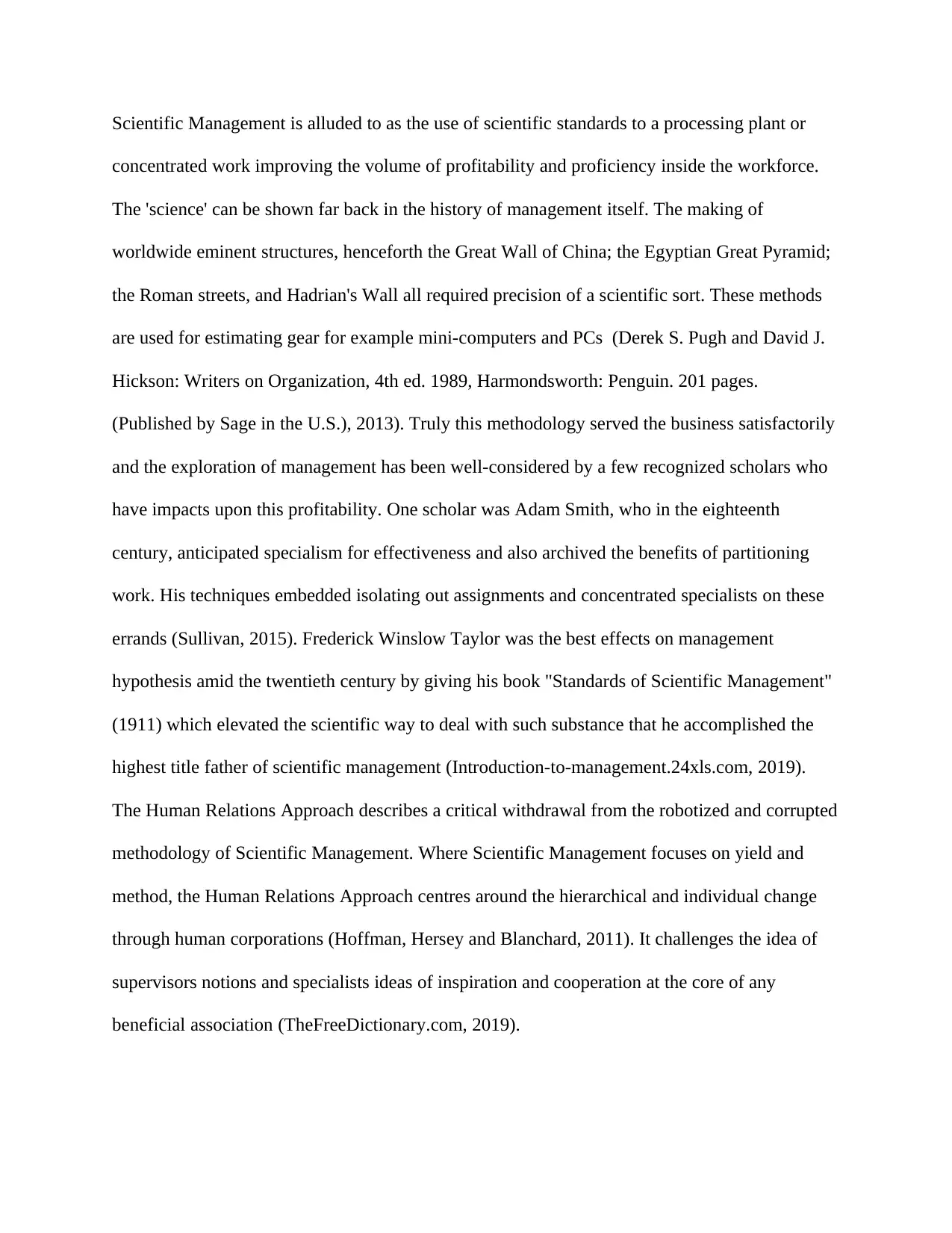
Scientific Management is alluded to as the use of scientific standards to a processing plant or
concentrated work improving the volume of profitability and proficiency inside the workforce.
The 'science' can be shown far back in the history of management itself. The making of
worldwide eminent structures, henceforth the Great Wall of China; the Egyptian Great Pyramid;
the Roman streets, and Hadrian's Wall all required precision of a scientific sort. These methods
are used for estimating gear for example mini-computers and PCs (Derek S. Pugh and David J.
Hickson: Writers on Organization, 4th ed. 1989, Harmondsworth: Penguin. 201 pages.
(Published by Sage in the U.S.), 2013). Truly this methodology served the business satisfactorily
and the exploration of management has been well-considered by a few recognized scholars who
have impacts upon this profitability. One scholar was Adam Smith, who in the eighteenth
century, anticipated specialism for effectiveness and also archived the benefits of partitioning
work. His techniques embedded isolating out assignments and concentrated specialists on these
errands (Sullivan, 2015). Frederick Winslow Taylor was the best effects on management
hypothesis amid the twentieth century by giving his book "Standards of Scientific Management"
(1911) which elevated the scientific way to deal with such substance that he accomplished the
highest title father of scientific management (Introduction-to-management.24xls.com, 2019).
The Human Relations Approach describes a critical withdrawal from the robotized and corrupted
methodology of Scientific Management. Where Scientific Management focuses on yield and
method, the Human Relations Approach centres around the hierarchical and individual change
through human corporations (Hoffman, Hersey and Blanchard, 2011). It challenges the idea of
supervisors notions and specialists ideas of inspiration and cooperation at the core of any
beneficial association (TheFreeDictionary.com, 2019).
concentrated work improving the volume of profitability and proficiency inside the workforce.
The 'science' can be shown far back in the history of management itself. The making of
worldwide eminent structures, henceforth the Great Wall of China; the Egyptian Great Pyramid;
the Roman streets, and Hadrian's Wall all required precision of a scientific sort. These methods
are used for estimating gear for example mini-computers and PCs (Derek S. Pugh and David J.
Hickson: Writers on Organization, 4th ed. 1989, Harmondsworth: Penguin. 201 pages.
(Published by Sage in the U.S.), 2013). Truly this methodology served the business satisfactorily
and the exploration of management has been well-considered by a few recognized scholars who
have impacts upon this profitability. One scholar was Adam Smith, who in the eighteenth
century, anticipated specialism for effectiveness and also archived the benefits of partitioning
work. His techniques embedded isolating out assignments and concentrated specialists on these
errands (Sullivan, 2015). Frederick Winslow Taylor was the best effects on management
hypothesis amid the twentieth century by giving his book "Standards of Scientific Management"
(1911) which elevated the scientific way to deal with such substance that he accomplished the
highest title father of scientific management (Introduction-to-management.24xls.com, 2019).
The Human Relations Approach describes a critical withdrawal from the robotized and corrupted
methodology of Scientific Management. Where Scientific Management focuses on yield and
method, the Human Relations Approach centres around the hierarchical and individual change
through human corporations (Hoffman, Hersey and Blanchard, 2011). It challenges the idea of
supervisors notions and specialists ideas of inspiration and cooperation at the core of any
beneficial association (TheFreeDictionary.com, 2019).
⊘ This is a preview!⊘
Do you want full access?
Subscribe today to unlock all pages.

Trusted by 1+ million students worldwide
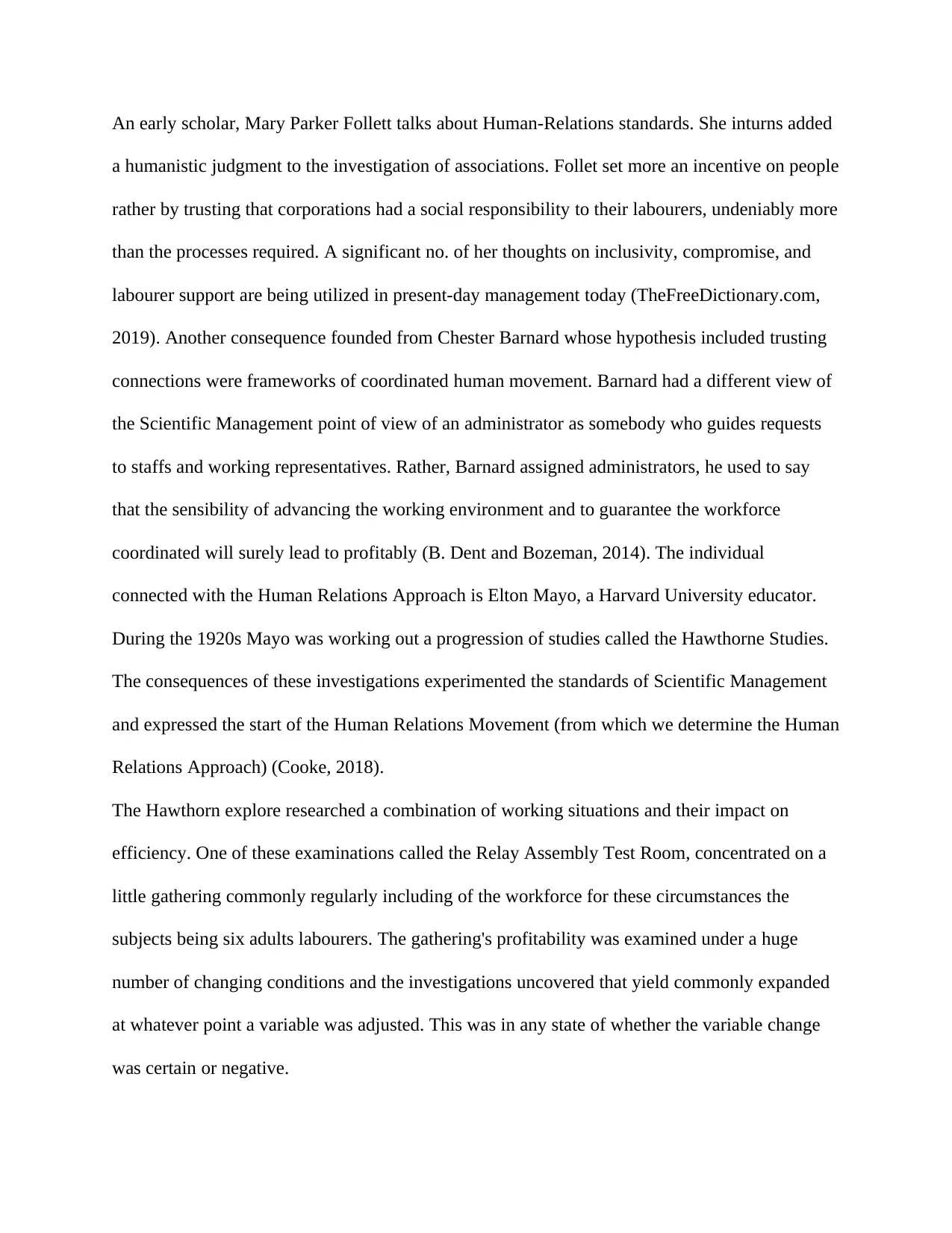
An early scholar, Mary Parker Follett talks about Human-Relations standards. She inturns added
a humanistic judgment to the investigation of associations. Follet set more an incentive on people
rather by trusting that corporations had a social responsibility to their labourers, undeniably more
than the processes required. A significant no. of her thoughts on inclusivity, compromise, and
labourer support are being utilized in present-day management today (TheFreeDictionary.com,
2019). Another consequence founded from Chester Barnard whose hypothesis included trusting
connections were frameworks of coordinated human movement. Barnard had a different view of
the Scientific Management point of view of an administrator as somebody who guides requests
to staffs and working representatives. Rather, Barnard assigned administrators, he used to say
that the sensibility of advancing the working environment and to guarantee the workforce
coordinated will surely lead to profitably (B. Dent and Bozeman, 2014). The individual
connected with the Human Relations Approach is Elton Mayo, a Harvard University educator.
During the 1920s Mayo was working out a progression of studies called the Hawthorne Studies.
The consequences of these investigations experimented the standards of Scientific Management
and expressed the start of the Human Relations Movement (from which we determine the Human
Relations Approach) (Cooke, 2018).
The Hawthorn explore researched a combination of working situations and their impact on
efficiency. One of these examinations called the Relay Assembly Test Room, concentrated on a
little gathering commonly regularly including of the workforce for these circumstances the
subjects being six adults labourers. The gathering's profitability was examined under a huge
number of changing conditions and the investigations uncovered that yield commonly expanded
at whatever point a variable was adjusted. This was in any state of whether the variable change
was certain or negative.
a humanistic judgment to the investigation of associations. Follet set more an incentive on people
rather by trusting that corporations had a social responsibility to their labourers, undeniably more
than the processes required. A significant no. of her thoughts on inclusivity, compromise, and
labourer support are being utilized in present-day management today (TheFreeDictionary.com,
2019). Another consequence founded from Chester Barnard whose hypothesis included trusting
connections were frameworks of coordinated human movement. Barnard had a different view of
the Scientific Management point of view of an administrator as somebody who guides requests
to staffs and working representatives. Rather, Barnard assigned administrators, he used to say
that the sensibility of advancing the working environment and to guarantee the workforce
coordinated will surely lead to profitably (B. Dent and Bozeman, 2014). The individual
connected with the Human Relations Approach is Elton Mayo, a Harvard University educator.
During the 1920s Mayo was working out a progression of studies called the Hawthorne Studies.
The consequences of these investigations experimented the standards of Scientific Management
and expressed the start of the Human Relations Movement (from which we determine the Human
Relations Approach) (Cooke, 2018).
The Hawthorn explore researched a combination of working situations and their impact on
efficiency. One of these examinations called the Relay Assembly Test Room, concentrated on a
little gathering commonly regularly including of the workforce for these circumstances the
subjects being six adults labourers. The gathering's profitability was examined under a huge
number of changing conditions and the investigations uncovered that yield commonly expanded
at whatever point a variable was adjusted. This was in any state of whether the variable change
was certain or negative.
Paraphrase This Document
Need a fresh take? Get an instant paraphrase of this document with our AI Paraphraser
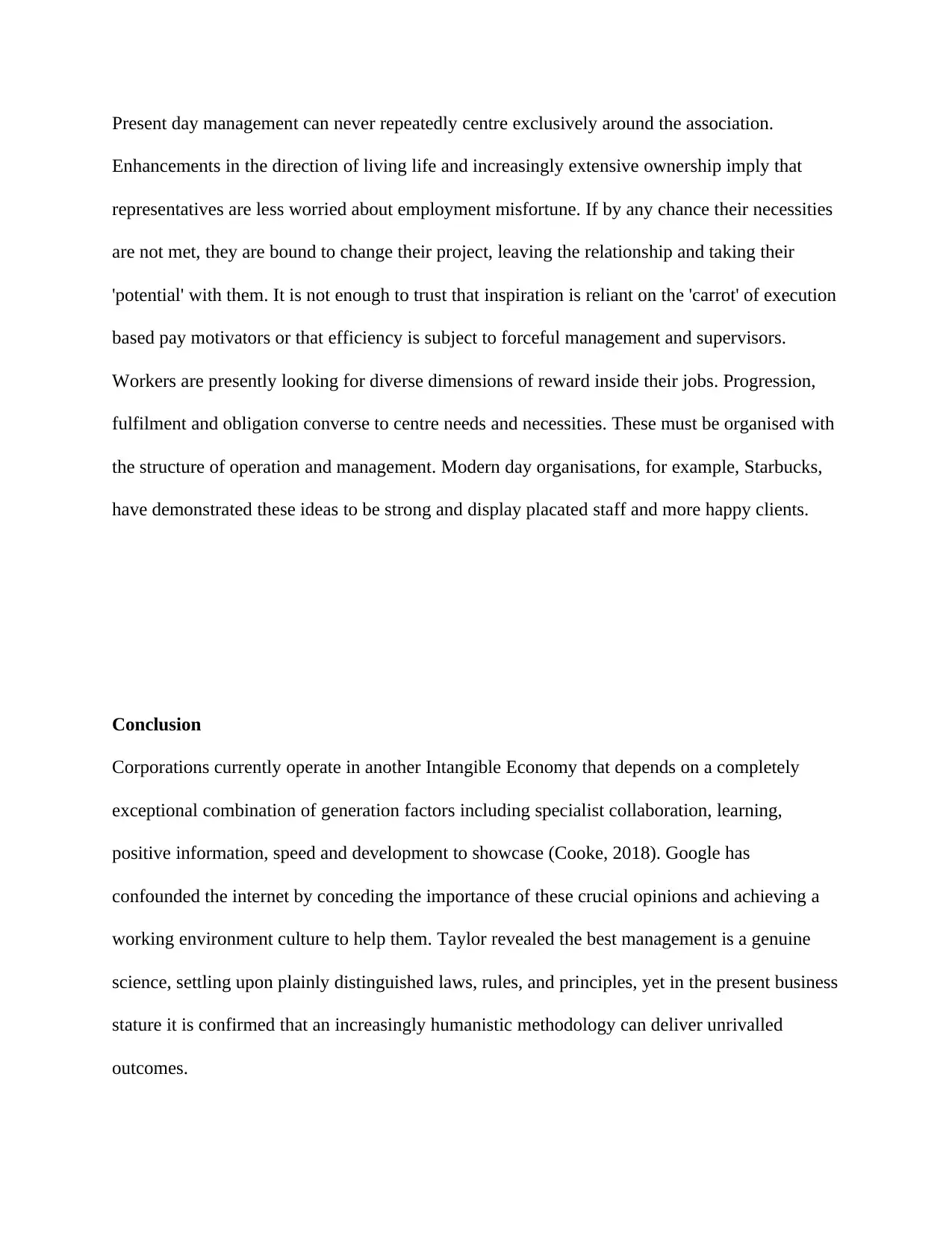
Present day management can never repeatedly centre exclusively around the association.
Enhancements in the direction of living life and increasingly extensive ownership imply that
representatives are less worried about employment misfortune. If by any chance their necessities
are not met, they are bound to change their project, leaving the relationship and taking their
'potential' with them. It is not enough to trust that inspiration is reliant on the 'carrot' of execution
based pay motivators or that efficiency is subject to forceful management and supervisors.
Workers are presently looking for diverse dimensions of reward inside their jobs. Progression,
fulfilment and obligation converse to centre needs and necessities. These must be organised with
the structure of operation and management. Modern day organisations, for example, Starbucks,
have demonstrated these ideas to be strong and display placated staff and more happy clients.
Conclusion
Corporations currently operate in another Intangible Economy that depends on a completely
exceptional combination of generation factors including specialist collaboration, learning,
positive information, speed and development to showcase (Cooke, 2018). Google has
confounded the internet by conceding the importance of these crucial opinions and achieving a
working environment culture to help them. Taylor revealed the best management is a genuine
science, settling upon plainly distinguished laws, rules, and principles, yet in the present business
stature it is confirmed that an increasingly humanistic methodology can deliver unrivalled
outcomes.
Enhancements in the direction of living life and increasingly extensive ownership imply that
representatives are less worried about employment misfortune. If by any chance their necessities
are not met, they are bound to change their project, leaving the relationship and taking their
'potential' with them. It is not enough to trust that inspiration is reliant on the 'carrot' of execution
based pay motivators or that efficiency is subject to forceful management and supervisors.
Workers are presently looking for diverse dimensions of reward inside their jobs. Progression,
fulfilment and obligation converse to centre needs and necessities. These must be organised with
the structure of operation and management. Modern day organisations, for example, Starbucks,
have demonstrated these ideas to be strong and display placated staff and more happy clients.
Conclusion
Corporations currently operate in another Intangible Economy that depends on a completely
exceptional combination of generation factors including specialist collaboration, learning,
positive information, speed and development to showcase (Cooke, 2018). Google has
confounded the internet by conceding the importance of these crucial opinions and achieving a
working environment culture to help them. Taylor revealed the best management is a genuine
science, settling upon plainly distinguished laws, rules, and principles, yet in the present business
stature it is confirmed that an increasingly humanistic methodology can deliver unrivalled
outcomes.
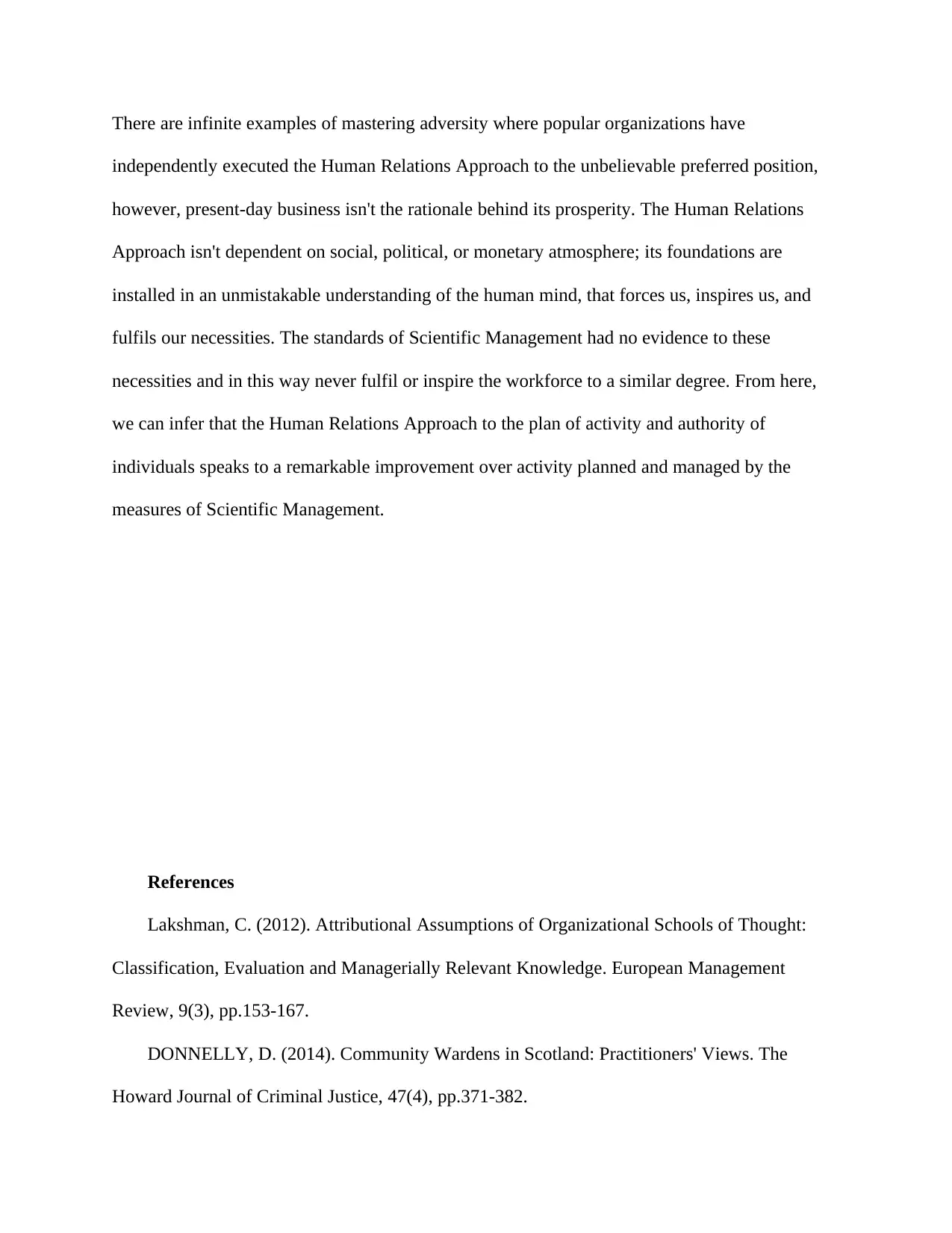
There are infinite examples of mastering adversity where popular organizations have
independently executed the Human Relations Approach to the unbelievable preferred position,
however, present-day business isn't the rationale behind its prosperity. The Human Relations
Approach isn't dependent on social, political, or monetary atmosphere; its foundations are
installed in an unmistakable understanding of the human mind, that forces us, inspires us, and
fulfils our necessities. The standards of Scientific Management had no evidence to these
necessities and in this way never fulfil or inspire the workforce to a similar degree. From here,
we can infer that the Human Relations Approach to the plan of activity and authority of
individuals speaks to a remarkable improvement over activity planned and managed by the
measures of Scientific Management.
References
Lakshman, C. (2012). Attributional Assumptions of Organizational Schools of Thought:
Classification, Evaluation and Managerially Relevant Knowledge. European Management
Review, 9(3), pp.153-167.
DONNELLY, D. (2014). Community Wardens in Scotland: Practitioners' Views. The
Howard Journal of Criminal Justice, 47(4), pp.371-382.
independently executed the Human Relations Approach to the unbelievable preferred position,
however, present-day business isn't the rationale behind its prosperity. The Human Relations
Approach isn't dependent on social, political, or monetary atmosphere; its foundations are
installed in an unmistakable understanding of the human mind, that forces us, inspires us, and
fulfils our necessities. The standards of Scientific Management had no evidence to these
necessities and in this way never fulfil or inspire the workforce to a similar degree. From here,
we can infer that the Human Relations Approach to the plan of activity and authority of
individuals speaks to a remarkable improvement over activity planned and managed by the
measures of Scientific Management.
References
Lakshman, C. (2012). Attributional Assumptions of Organizational Schools of Thought:
Classification, Evaluation and Managerially Relevant Knowledge. European Management
Review, 9(3), pp.153-167.
DONNELLY, D. (2014). Community Wardens in Scotland: Practitioners' Views. The
Howard Journal of Criminal Justice, 47(4), pp.371-382.
⊘ This is a preview!⊘
Do you want full access?
Subscribe today to unlock all pages.

Trusted by 1+ million students worldwide
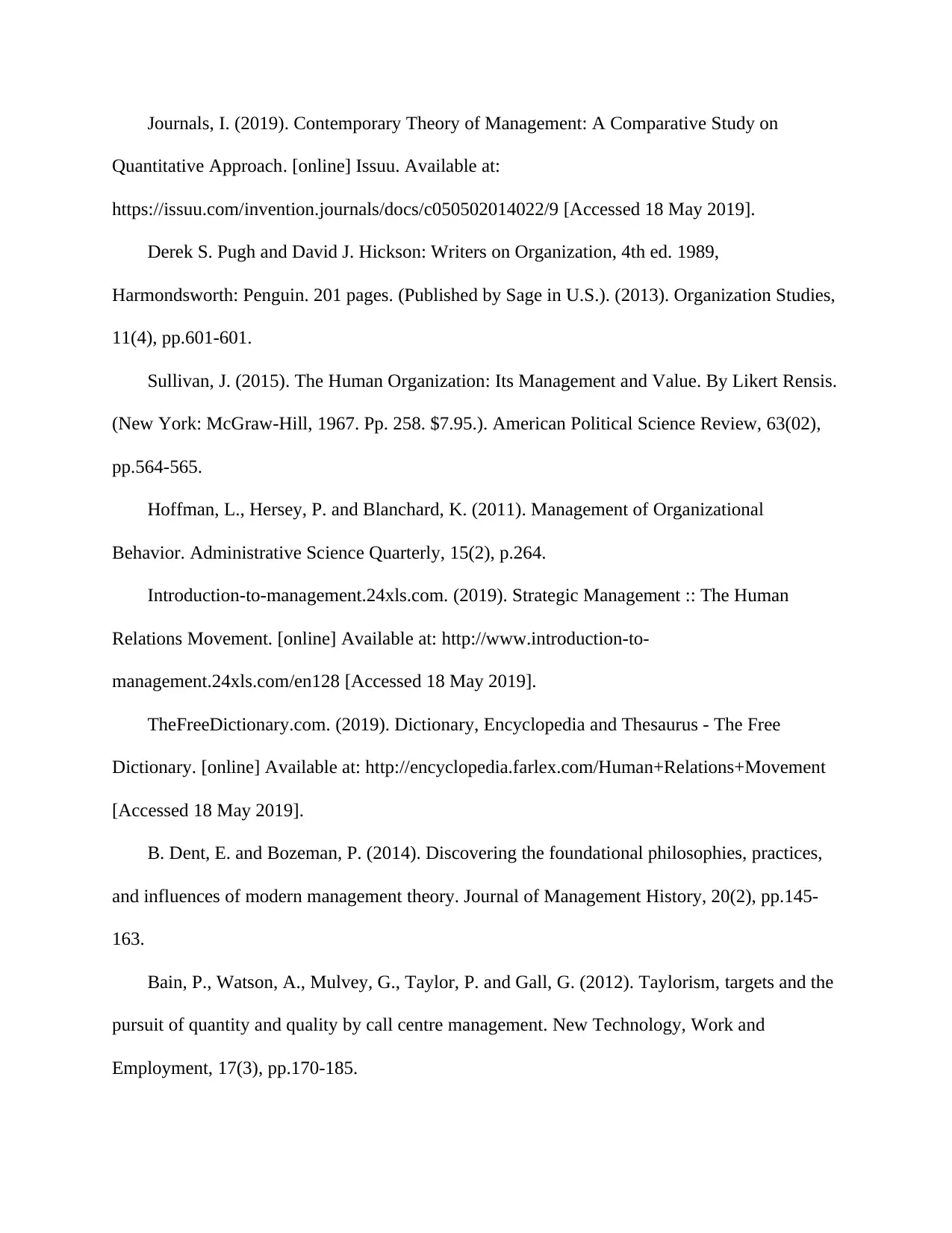
Journals, I. (2019). Contemporary Theory of Management: A Comparative Study on
Quantitative Approach. [online] Issuu. Available at:
https://issuu.com/invention.journals/docs/c050502014022/9 [Accessed 18 May 2019].
Derek S. Pugh and David J. Hickson: Writers on Organization, 4th ed. 1989,
Harmondsworth: Penguin. 201 pages. (Published by Sage in U.S.). (2013). Organization Studies,
11(4), pp.601-601.
Sullivan, J. (2015). The Human Organization: Its Management and Value. By Likert Rensis.
(New York: McGraw-Hill, 1967. Pp. 258. $7.95.). American Political Science Review, 63(02),
pp.564-565.
Hoffman, L., Hersey, P. and Blanchard, K. (2011). Management of Organizational
Behavior. Administrative Science Quarterly, 15(2), p.264.
Introduction-to-management.24xls.com. (2019). Strategic Management :: The Human
Relations Movement. [online] Available at: http://www.introduction-to-
management.24xls.com/en128 [Accessed 18 May 2019].
TheFreeDictionary.com. (2019). Dictionary, Encyclopedia and Thesaurus - The Free
Dictionary. [online] Available at: http://encyclopedia.farlex.com/Human+Relations+Movement
[Accessed 18 May 2019].
B. Dent, E. and Bozeman, P. (2014). Discovering the foundational philosophies, practices,
and influences of modern management theory. Journal of Management History, 20(2), pp.145-
163.
Bain, P., Watson, A., Mulvey, G., Taylor, P. and Gall, G. (2012). Taylorism, targets and the
pursuit of quantity and quality by call centre management. New Technology, Work and
Employment, 17(3), pp.170-185.
Quantitative Approach. [online] Issuu. Available at:
https://issuu.com/invention.journals/docs/c050502014022/9 [Accessed 18 May 2019].
Derek S. Pugh and David J. Hickson: Writers on Organization, 4th ed. 1989,
Harmondsworth: Penguin. 201 pages. (Published by Sage in U.S.). (2013). Organization Studies,
11(4), pp.601-601.
Sullivan, J. (2015). The Human Organization: Its Management and Value. By Likert Rensis.
(New York: McGraw-Hill, 1967. Pp. 258. $7.95.). American Political Science Review, 63(02),
pp.564-565.
Hoffman, L., Hersey, P. and Blanchard, K. (2011). Management of Organizational
Behavior. Administrative Science Quarterly, 15(2), p.264.
Introduction-to-management.24xls.com. (2019). Strategic Management :: The Human
Relations Movement. [online] Available at: http://www.introduction-to-
management.24xls.com/en128 [Accessed 18 May 2019].
TheFreeDictionary.com. (2019). Dictionary, Encyclopedia and Thesaurus - The Free
Dictionary. [online] Available at: http://encyclopedia.farlex.com/Human+Relations+Movement
[Accessed 18 May 2019].
B. Dent, E. and Bozeman, P. (2014). Discovering the foundational philosophies, practices,
and influences of modern management theory. Journal of Management History, 20(2), pp.145-
163.
Bain, P., Watson, A., Mulvey, G., Taylor, P. and Gall, G. (2012). Taylorism, targets and the
pursuit of quantity and quality by call centre management. New Technology, Work and
Employment, 17(3), pp.170-185.
Paraphrase This Document
Need a fresh take? Get an instant paraphrase of this document with our AI Paraphraser
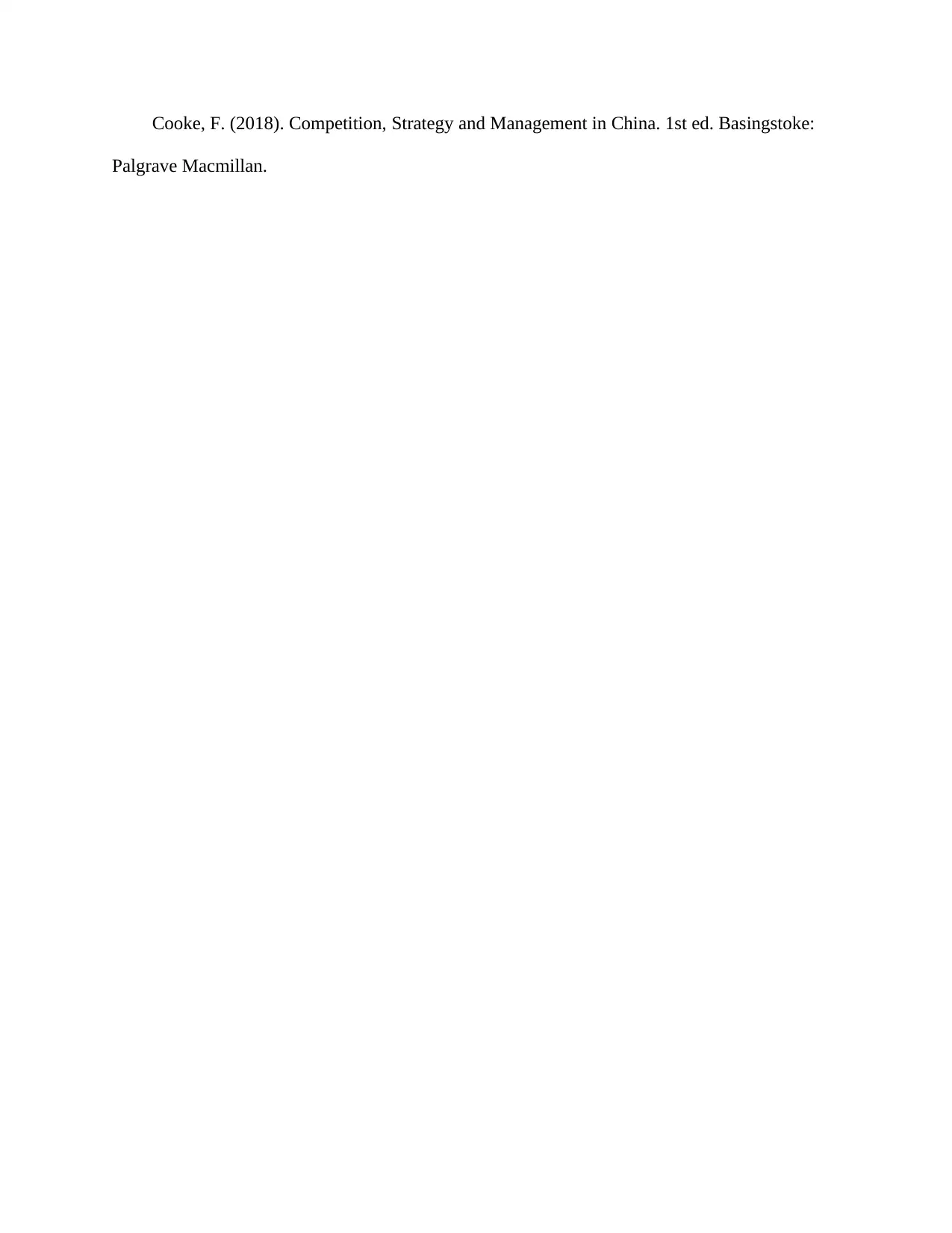
Cooke, F. (2018). Competition, Strategy and Management in China. 1st ed. Basingstoke:
Palgrave Macmillan.
Palgrave Macmillan.
1 out of 8
Your All-in-One AI-Powered Toolkit for Academic Success.
+13062052269
info@desklib.com
Available 24*7 on WhatsApp / Email
![[object Object]](/_next/static/media/star-bottom.7253800d.svg)
Unlock your academic potential
Copyright © 2020–2025 A2Z Services. All Rights Reserved. Developed and managed by ZUCOL.